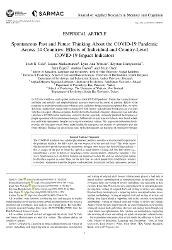| dc.contributor.author | Cole, Scott N. | |
| dc.contributor.author | Markostamou, Ioanna | |
| dc.contributor.author | Watson, Lynn Ann | |
| dc.contributor.author | Barzykowski, Krystian | |
| dc.contributor.author | Ergen, Irem | |
| dc.contributor.author | Taylor, Andrea | |
| dc.contributor.author | Oner, Sezin | |
| dc.date.accessioned | 2023-10-19T15:11:33Z | |
| dc.date.available | 2023-10-19T15:11:33Z | |
| dc.date.issued | 2022 | |
| dc.identifier.issn | 2211-3681 | |
| dc.identifier.issn | 2211-369X | |
| dc.identifier.uri | https://doi.org/10.1037/mac0000071 | |
| dc.identifier.uri | https://hdl.handle.net/20.500.12469/5080 | |
| dc.description.abstract | In 2020, the world was amid a global health crisis-the COVID-19 pandemic. Nations had varying levels of morbidity and mortality and adopted different measures to prevent the spread of infection. Effects of the pandemic on spontaneous (rather than voluntary) past and future thoughts remain unexplored. Here, we report data from a multicountry online study examining how both country- and individual-level factors are associated with this core aspect of human cognition. Results showed that national (stringency of measures) and individual (attention to COVID-related information and worry) factors separately and jointly predicted the frequency of people's pandemic-related spontaneous thoughts. Additionally, no typical positivity biases were found, as both past and future spontaneous thoughts had a negative emotional valence. This large-scale multinational study provides novel insights toward better understanding the emergence and qualities of spontaneous past and future thoughts. Findings are discussed in terms of the determinants and functions of spontaneous thought. General Audience Summary The COVID-19 pandemic was a global phenomenon; people in countries across the world experienced the pandemic similarly, but did it affect the way we perceived the past and future? This study reports whether and how people experienced spontaneous thoughts about the past and future of the pandemic-that is, images of the past or future that appear in mind without warning and with little effort (e.g., remembering a recent lockdown or imagining a future announcement)-during the pandemic's first wave. Spontaneous past and future thoughts are important in daily life and can indicate poor mental health when negative in nature. Here, for the first time, we asked people from 14 different countries across four continents to report the frequency and emotional characteristics of their spontaneous past and future pandemic-related thoughts in the first wave of the pandemic. The study showed that the national context (in particular, COVID regulations) predicted the frequency of people's spontaneous thoughts about the pandemic. Emotional aspects of these thoughts were predicted by individual factors such as isolation, worry, attention to COVID-related information, and impact of COVID-19 on everyday life, in addition to national factors. Finally, in contrast to previous research showing a positive bias, which is thought to be beneficial, past and future spontaneous pandemic-related thoughts had a negative emotional tone. This study allowed us to demonstrate that the tendency to experience spontaneous thoughts about an ongoing international event can be predicted by societal context, which may be valuable for examining the social predictors of spontaneous emotional thoughts about the past and future. The study also characterized the negative tone of past and future spontaneous thoughts about the pandemic, and future studies will be needed to examine the longer term consequences of these effects. | en_US |
| dc.language.iso | eng | en_US |
| dc.publisher | Amer Psychological Assoc | en_US |
| dc.relation.ispartof | Journal of Applied Research in Memory and Cognition | en_US |
| dc.rights | info:eu-repo/semantics/openAccess | en_US |
| dc.subject | Involuntary Autobiographical Memories | En_Us |
| dc.subject | Mental Time-Travel | En_Us |
| dc.subject | spontaneous thought | en_US |
| dc.subject | mental time travel | en_US |
| dc.subject | involuntary memory | en_US |
| dc.subject | future thinking | en_US |
| dc.subject | COVID-19 | en_US |
| dc.title | Spontaneous Past and Future Thinking About the COVID-19 Pandemic Across 14 Countries: Effects of Individual and Country-Level COVID-19 Impact Indicators | en_US |
| dc.type | article | en_US |
| dc.authorid | Ergen, Irem/0000-0003-0703-111X | |
| dc.authorid | Barzykowski, Krystian/0000-0003-4016-3966 | |
| dc.authorid | Watson, Lynn Ann/0000-0001-5150-1217 | |
| dc.authorid | Taylor, Andrea/0000-0002-2856-0478 | |
| dc.authorid | Markostamou, Ioanna/0000-0001-7343-0122 | |
| dc.authorid | Cole, Scott/0000-0001-8176-283X | |
| dc.department | N/A | en_US |
| dc.identifier.wos | WOS:000872782300001 | en_US |
| dc.identifier.doi | 10.1037/mac0000071 | en_US |
| dc.identifier.scopus | 2-s2.0-85142274930 | en_US |
| dc.institutionauthor | N/A | |
| dc.relation.publicationcategory | Makale - Uluslararası Hakemli Dergi - Kurum Öğretim Elemanı | en_US |
| dc.authorwosid | Ergen, Irem/HNQ-3745-2023 | |
| dc.authorwosid | Barzykowski, Krystian/AAJ-5797-2021 | |
| dc.khas | 20231019-WoS | en_US |
















